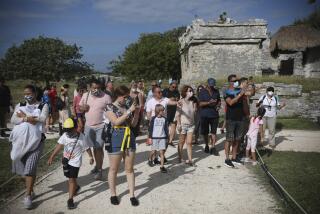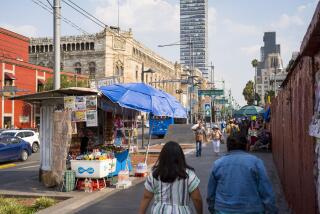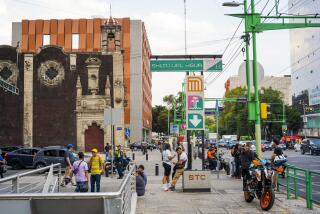With Bargains and Cheap Air Fares, Cancun Packs In the Party Crowd
Itâs a rowdy afternoon at the swim-up bar of the Caribbean Village resort in Mexicoâs Cancun. The sun is shining, the rock music blaring and the liquor flowing. âThis is where the party is!â hooted my new acquaintance, 23-year-old Derek from Toronto. Then he tilted his head back so his girlfriend of the moment could pour an electric-green stream of who-knows-what down his throat.
This is just the image many Americans have of the skinny, 14-mile-long island off Mexicoâs gulf coast--especially around spring break in North America, when hordes of college students come a-flocking to party hearty. Avenida Kukulcan, the main drag in Cancunâs Americanized hotel zone, is lined with monuments to Yankee commercialism. Planet Hollywood, Hard Rock Cafe, Burger King, Hooters--theyâre all here among the 200 local eateries, and all hopping. Young adults whoop it up daily at the new Wet ânâ Wild water park (complete with open bar) and nightly at clubs. Events such as Mayâs Jazz Week regularly attract world-famous headliners. Most locals speak English, and prices are frequently quoted in U.S. dollars.
Yet this is far from the whole story. Compared with high-rise urban resorts such as Acapulco, Miami Beach and Waikiki, the hotel zone is unusually restrained--often architecturally interesting, and unmarred by skyscrapers. Fine dining and upscale lodgings abound, and among the white powdery beaches itâs usually not too hard to find an uncrowded stretch to savor the incredibly turquoise waters and relax in peace. The area has low crime and can serve as a convenient base to explore Yucatanâs Spanish colonial cities and the ruins of the Mayan civilization. Day trips to nearby Cozumel and Isla Mujeres, meanwhile, offer old-fashioned island tranquillity (not to mention great scuba diving).
All of this, and 2.5 million visitors a year, seemed rather unlikely back in the early 1970s, when tourism development planners chose a swampy sandbar (whose name is Mayan for âsnakesâ nestâ) to transform into Mexicoâs newest vacationland. But the first of the hotels, El Presidente, went up in 1974, and they havenât stopped coming.
Last month, the luxury Hotel Dunas became the 148th, and several more are scheduled to open by next year. Many of these are all-inclusive resorts, while others include breakfast at most. They range from the $395-a-night Ritz-Carlton down to clean-but-modest properties costing as little as $12 (often on the mainland).
Bargains in the hotel zone include the Hotel Aristos, telephone (800) 527-4786, where a double without meals starts at $84, and the Dos Playas, tel. 011-52-98-830-500, where rooms start at $67. Exceptional values include Allegroâs Caribbean Village and Jack Tar Village, tel. (800) 858-2258, whose regular rates are $125 and $130 per person per night, respectively (including three meals daily, unlimited drinks, unlimited sports and entertainment), but which are often packaged with air fare for about $1,200 for six nights. The newly refurbished Club Med, tel. (800) 258-2633, is in the same ballpark, at $114 to $125 (again all-inclusive) per person per night, with weeklong air-land packages also sometimes available for about $1,000. (The resort will reopen Sept. 6.)
Getting there is also a relative bargain. Consolidator air fares can be gotten from most of the continental U.S. for less than $400 round-trip per person, and special promotional fares can bring it lower than $300. Furthermore, air-land deals for three nights are also regularly available through travel agencies and vendors such as Interisland Tours, tel. (800) 245-3434, for as little as $536 per person, double occupancy.
You can keep costs down by paying in pesos, taking the convenient public buses (47 cents) instead of taxis and avoiding turista traps, where a burger can set you back $10. Banks and the exchange bureaus provide better rates than hotels and the airport.
As tourism runs out of room on Cancun island, it is spilling onto the mainlandâs Mayan Riviera, with major developments planned for 1999 in the Punta Sam region to the north and Zone Three to the south, not far from the airport. And thereâs the ever-expanding (and even more affordable) Playa del Carmen resort area on the coast, about an hourâs drive south. But with continuing annual increases in visitors, for the foreseeable future Cancun is still numero uno among Mexicoâs tourist draws.
For more information, contact the Mexican National Tourist Office, 2401 W. 6th St., Los Angeles, CA 90057; tel. (213) 351-2069.
More to Read
Sign up for The Wild
Weâll help you find the best places to hike, bike and run, as well as the perfect silent spots for meditation and yoga.
You may occasionally receive promotional content from the Los Angeles Times.






